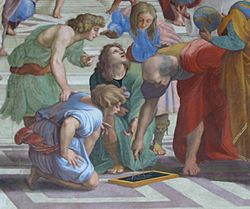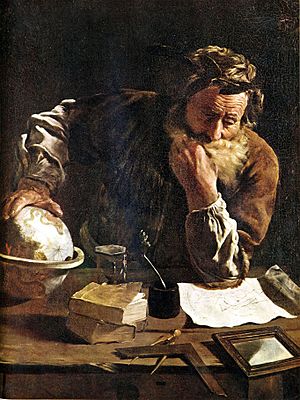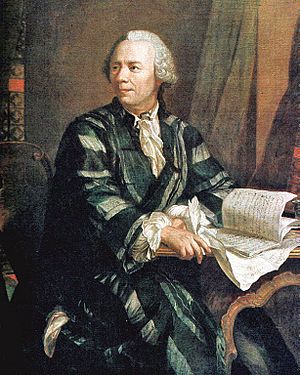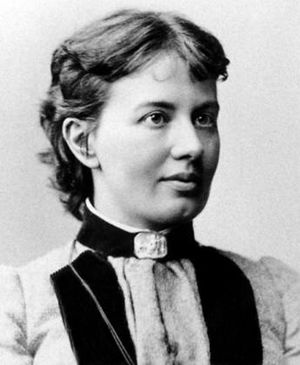Mathematician facts for kids

Euclid (holding calipers), Greek mathematician, known as the "Father of Geometry"
|
|
| Occupation | |
|---|---|
|
Occupation type
|
Academic |
| Description | |
| Competencies | Mathematics, analytical skills and critical thinking skills |
|
Education required
|
Doctoral degree, occasionally master's degree |
|
Fields of
employment |
universities, private corporations, financial industry, government |
|
Related jobs
|
statistician, actuary |
A mathematician is a person who studies mathematics. They might do it for fun or as their job. Many mathematicians teach math at colleges and universities.
Some famous mathematicians include Euclid, Ramanujan, and Sir Isaac Newton. Mathematics is all about numbers, data, and how things change. It also looks at patterns, space, and models.
Contents
What Do Mathematicians Do?
Mathematicians explore numbers, shapes, and patterns. They use logic and problem-solving skills. Their work helps us understand the world better.
Solving Real-World Problems

Mathematicians who solve problems in real life are called applied mathematicians. They use their math skills to help in science, engineering, and business. For example, they might create mathematical models. These models help predict things or understand how systems work.
Applied mathematicians are part of STEM careers. STEM stands for science, technology, engineering, and mathematics. They use math to solve many challenging problems.
Exploring Abstract Ideas

Some mathematicians study pure mathematics. This means they explore ideas that are completely abstract. They look at math concepts for their own sake. They do not always worry about how these ideas apply to the real world.
Even though pure and applied math seem different, they often work together. Applied mathematicians use tools from pure math. Pure mathematicians get ideas from real-world problems.
Teaching Mathematics
Many mathematicians also teach math. They work at universities and colleges. Their jobs can include teaching math classes to students. They also guide students who are doing their own research. Plus, they serve on school committees.
Working as a Consultant
Many math careers outside of universities involve consulting. For example, actuaries use math to figure out risks. They look at data to guess the chance and cost of events. This could be things like sickness or property loss.
Actuaries also help with money questions. They figure out how much money is needed for pensions. They also advise companies on how to invest. They help design insurance plans and financial strategies. This makes sure these plans are financially sound.
Another example is in financial math. These mathematicians use math to understand how financial markets work. They might use complex math to value things like derivatives.
Math-Related Jobs
The Dictionary of Occupational Titles lists many jobs related to mathematics. These include:
- Mathematician
- Operations-Research Analyst
- Mathematical Statistician
- Mathematical Technician
- Actuary
- Applied Statistician
- Weight Analyst
Images for kids
-
Emmy Noether, a very important mathematical thinker and teacher.
See also
 In Spanish: Matemático para niños
In Spanish: Matemático para niños




